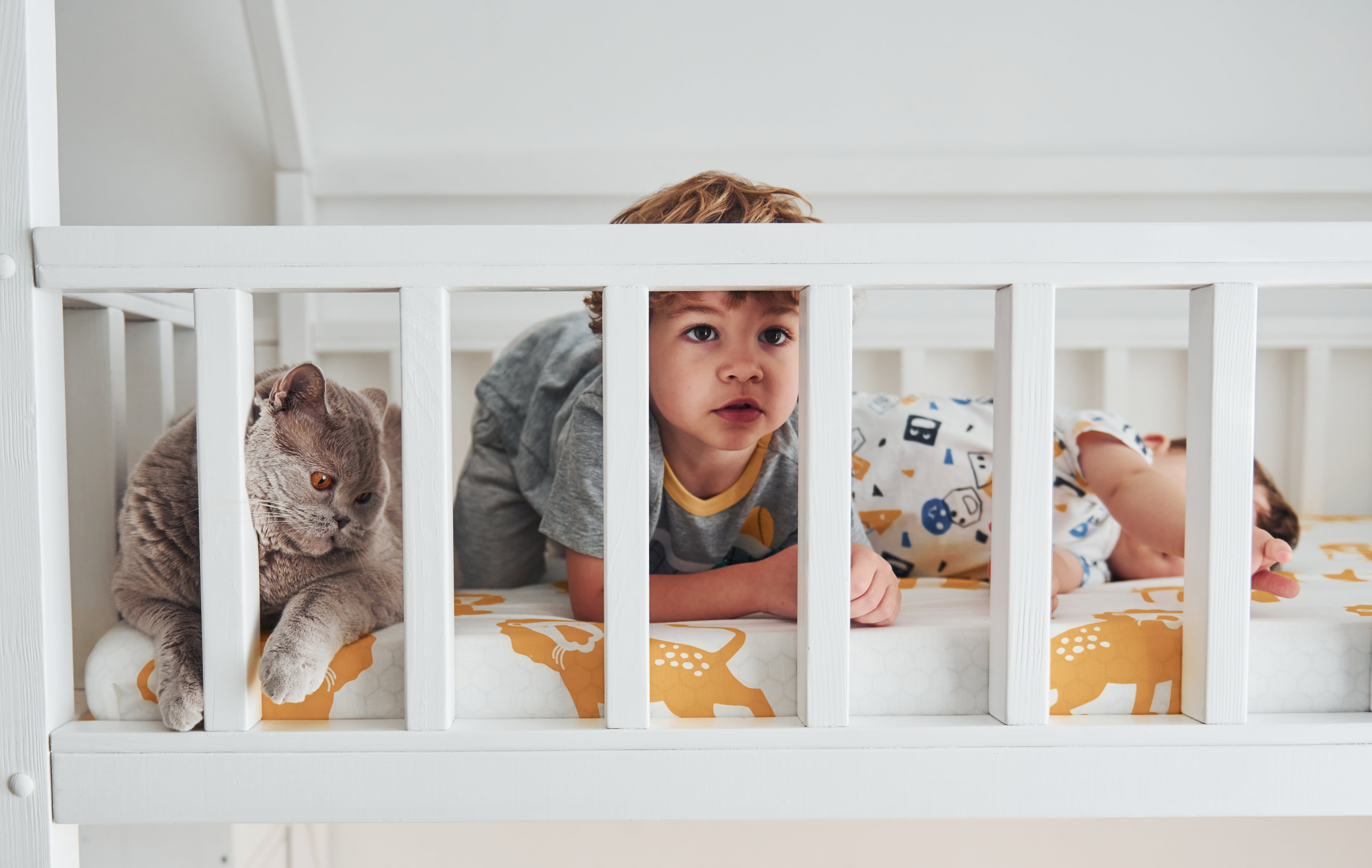Bedside Co-Sleeper - What is a Bedside Co-Sleeper?
A bedside co-sleeper consists of a bassinet welded to the mattress's side that allows you to reach your baby during the middle of the night. This type of cosleeping has been recommended by the NHS as well as the Lullaby Trust as it allows you to keep your baby close, without risking SIDS.
Peace of Mind
Co-sleeping is a vital parenting decision. While some parents are concerned about the possibility that sleeping close to their child increases the risk of SIDS, studies like those published by NHS suggest otherwise. Co-sleeping is a form of sharing a sleeping space which could increase the risk of SIDS. Co-sleeping beds in cots have been designed to offer an appropriate place to rest between bed sharing and separate sleeping areas that allow parents to be able to reach out over their child and effortlessly soothe them without leaving the security of their own bed.
Babies sleep best when they are fed and comforted regularly However, exhausted parents may find it difficult to leave their beds in order to feed or comfort them. The bedside co-sleeper gives parents the option to keep their baby close and not need to leave their comfortable bedding. The innovative design of some co sleepers, like the SnuzPod also permits the four walls to slide down and transform the co-sleeper into a cradle that has an extra layer of protection which makes it easier for parents who are tired to keep an eye on their newborn while remaining in their bed.
Even a small amount of alcohol or drugs can increase the risk of SIDS. It's also not a good idea to co-sleep with a baby if the father or mother has an history of having a snore. The NHS suggests that babies are placed to sleep on their backs to reduce the chance of rolling and death. The safest choice is to utilize a cot at the bedside or bassinet, or cradle.
Safety
While co-sleeping is a common practice in a variety of countries However, the NHS suggests that infants sleep in their own cribs rather than sharing your bed. This is due to the higher risk of suffocation and overheating. Babies who sleep with their parents are more likely to be covered by blankets, pillows or sheets. This could lead to SIDS. A crib for bed is an ideal solution. The crib is close to the parents, preventing suffocation or overheating of the baby. It can still be easily reached for nighttime feedings and comforting.
Parents from all over the world were eagerly anticipating the Dutch cosleeping pod when it first became viral in 2004. They wanted to test safe cosleeping. Despite the excitement, doctors do not fully believe in a sleeping bed that attaches to the side of a adult bed.
The primary concern is that a parent can roll over the infant, causing suffocation or strangulation. The risk of this is especially high if the parent is smoking, drinking alcohol or taking drugs while asleep. Overheating, falling and maternal death are also a possibility.
If you choose to opt for a bedside sleeper, it is crucial to select one that meets the highest standards of safety. The mattress should be snugly fitted without gaps and should not be prone to sagging. You should also be familiar with the recommended weight and age for the sleeper.
All new bedside beds will have to comply with the new safety standard that was announced in November 2020. It replaces the previous standards. There may be older models on sale in a few stores but they are gradually disappearing as manufacturers move to the new safety standards.
If you are considering purchasing a secondhand model, check that it's in good condition. Make sure that the mechanism that secures the bed to the parent's bed is sturdy and does not leave a gap. You should also ensure that the mattress fits properly within the sleeper without any gaps or bulges. The sheets should also fit comfortably so that the baby doesn't slide into a pocket and get trapped or even suffocate.
Convenience
Many new parents experience a natural urge to be by their child's side at night, however sleep experts such as Lullaby Trust recommend avoiding bed-sharing. Using a bedside crib or bassinet is a better option. They are designed to be attached to the sides of parents' bed, keeping baby in reach to feed at night and providing comfort. bedside cots allows parents to rest comfortably at the end of the night without having to leave their bed.
Babies who have separate bedrooms are more likely to have breathing pauses (apnoea) and are also at a higher risk of SIDS. According to research babies sleep better when they are with their parents. You can also quickly respond to any issue or concern your baby, making them more comfortable.
The best bedside bassinet or crib for your family depends on several aspects, including the living situation and future plans. If you live with a person who is a friend, or if your child is likely to be using the crib as he grows in age, it might be beneficial to select a convertible crib that will grow into solitary cribs or toddlers beds. We recommend contacting us to inquire about this option.
The bedside crib fosters bonding between the mother and baby. It is a convenient and safe option for parents who are exhausted. Research has shown that mothers who breastfeed tend to nurse for longer if their baby's close. This leads to a stronger attachment between the two.

This is the reason why a bedside cot is so popular, and a good option for any new mom who wishes to keep their baby close. When buying a bassinet, or co-sleeper, it is essential to ensure that it complies with the Lullaby Trust and safe sleep guidelines. Also, you should take into consideration your budget, as there are many options available.
